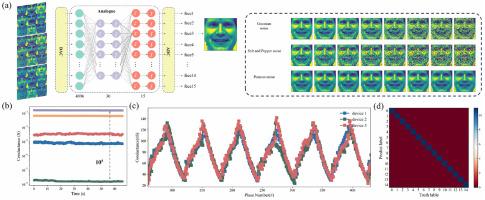当前位置:
X-MOL 学术
›
Mater. Today Phys.
›
论文详情
Our official English website, www.x-mol.net, welcomes your
feedback! (Note: you will need to create a separate account there.)
MoS2-based quantum dot artificial synapses for neuromorphic computing
Materials Today Physics ( IF 10.0 ) Pub Date : 2025-03-18 , DOI: 10.1016/j.mtphys.2025.101703
Gongjie Liu , Haoqi Liu , Feifan Fan , Yuefeng Gu , Lisi Wei , Xiaolin Xiang , Yuhao Wang , Qiuhong Li
Materials Today Physics ( IF 10.0 ) Pub Date : 2025-03-18 , DOI: 10.1016/j.mtphys.2025.101703
Gongjie Liu , Haoqi Liu , Feifan Fan , Yuefeng Gu , Lisi Wei , Xiaolin Xiang , Yuhao Wang , Qiuhong Li

|
The advancement of deep learning has escalated computational requirements. Neuromorphic devices, particularly those based on memristors, present strong potential to meet these demands. However, current memristors face challenges such as a low on/off ratio and poor linearity, which hinder the progress of neuromorphic computing. Here, we propose a MoS2 -based quantum dot memristor, where the presence of quantum dots facilitates the formation and stability of conductive channels. The device exhibits narrow set and reset voltage distributions, with an on/off ratio reaching 105 and multiple resistive states. Based on these multi-state characteristics, we achieved parallel image processing with various operators. The excitatory postsynaptic current (EPSC), spike-timing-dependent plasticity (STDP), paired-pulse facilitation (PPF), long-term potentiation (LTP), and long-term depression (LTD) characteristics of the device were tested, with the linearity of LTP and LTD being 0.21 and −0.25, respectively. Based on the good linearity of weight updates, we built an artificial neural network to recognize facial images with Gaussian, salt-and-pepper, and Poisson noise. At noise levels of 40 %, 48 %, and λ = 80, the recognition accuracy rates were still as high as 100 %, 100 %, and 97.33 %, respectively. This work provides a valuable reference for quantum dot-based neuromorphic computing.
中文翻译:

用于神经形态计算的基于 MoS2 的量子点人工突触
深度学习的进步提高了计算要求。神经形态器件,尤其是那些基于忆阻器的器件,在满足这些需求方面具有强大的潜力。然而,当前的忆阻器面临着低导通比和线性度差等挑战,这阻碍了神经形态计算的发展。在这里,我们提出了一种基于 MoS2 的量子点忆阻器,其中量子点的存在促进了导电通道的形成和稳定性。该器件具有较窄的设置和复位电压分布,开/关比达到 105 和多种电阻状态。基于这些多状态特性,我们实现了与各种算子的并行图像处理。测试了该装置的兴奋性突触后电流 (EPSC) 、尖峰时间依赖性可塑性 (STDP) 、成对脉冲促进 (PPF) 、长时程增强 (LTP) 和长期抑制 (LTD) 特性,LTP 和 LTD 的线性度分别为 0.21 和 -0.25。基于权重更新的良好线性,我们构建了一个人工神经网络来识别具有高斯、胡椒盐和泊松噪声的面部图像。在 40 %、48 % 和 λ = 80 的噪声水平下,识别准确率仍分别高达 100 %、100 % 和 97.33 %。这项工作为基于量子点的神经形态计算提供了有价值的参考。
更新日期:2025-03-18
中文翻译:

用于神经形态计算的基于 MoS2 的量子点人工突触
深度学习的进步提高了计算要求。神经形态器件,尤其是那些基于忆阻器的器件,在满足这些需求方面具有强大的潜力。然而,当前的忆阻器面临着低导通比和线性度差等挑战,这阻碍了神经形态计算的发展。在这里,我们提出了一种基于 MoS2 的量子点忆阻器,其中量子点的存在促进了导电通道的形成和稳定性。该器件具有较窄的设置和复位电压分布,开/关比达到 105 和多种电阻状态。基于这些多状态特性,我们实现了与各种算子的并行图像处理。测试了该装置的兴奋性突触后电流 (EPSC) 、尖峰时间依赖性可塑性 (STDP) 、成对脉冲促进 (PPF) 、长时程增强 (LTP) 和长期抑制 (LTD) 特性,LTP 和 LTD 的线性度分别为 0.21 和 -0.25。基于权重更新的良好线性,我们构建了一个人工神经网络来识别具有高斯、胡椒盐和泊松噪声的面部图像。在 40 %、48 % 和 λ = 80 的噪声水平下,识别准确率仍分别高达 100 %、100 % 和 97.33 %。这项工作为基于量子点的神经形态计算提供了有价值的参考。

































 京公网安备 11010802027423号
京公网安备 11010802027423号